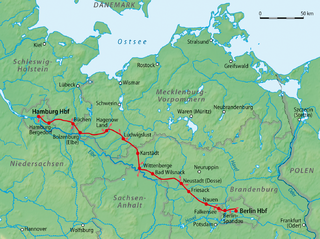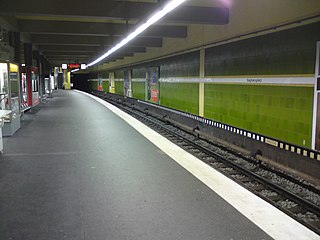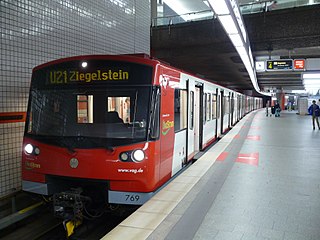
The Hamburg S-Bahn is a suburban commuter railway network in the Hamburg Metropolitan Region. Together, the S-Bahn, the Hamburg U-Bahn, the AKN railway and the regional railway form the backbone of railway public transport in the city and the surrounding area. The network has operated since 1907 as a commuter rail system, under the direction of the state railway, and is a member of the Hamburger Verkehrsverbund. There are six lines, serving 68 stations, on 147 kilometres (91 mi) of route. On an average working day the S-Bahn transports about 590,000 passengers; in 2010 about 221 million people used the S-Bahn.

The Hamburg U-Bahn is a rapid transit system serving the cities of Hamburg, Norderstedt, and Ahrensburg in Germany. Although referred to by the term U-Bahn, most of the system's track length is above ground. The network is interconnected with the city's S-Bahn system, which also has underground sections. It is operated by Hamburger Hochbahn within the Hamburger Verkehrsverbund (HVV). It was opened in February 1912, and comprises four lines serving 93 stations, with a route length of 106.4 kilometres (66.1 mi) in 2019.

Hamburger Hochbahn AG (HHA), founded in 1911, operates the underground system and large parts of the bus system in Hamburg, Germany.

Linienzugbeeinflussung is a cab signalling and train protection system used on selected German and Austrian railway lines as well as on the AVE and some commuter rail lines in Spain. The system was mandatory where trains were allowed to exceed speeds of 160 km/h (99 mph) in Germany and 220 km/h (140 mph) in Spain. It is also used on some slower railway and urban rapid transit lines to increase capacity. The German Linienzugbeeinflussung translates to continuous train control, literally: linear train influencing. It is also called linienförmige Zugbeeinflussung.

The Class 420 is a commuter electric multiple unit train type in service on German S-Bahn networks since 1972. Their use in Munich during the 1972 Summer Olympics earned them the colloquial name Olympiatriebwagen.

Jungfernstieg is an underground railway station in the city centre of Hamburg, Germany, served by the underground railway (U-Bahn) and the suburban railway (S-Bahn). The station is one of Hamburg's busiest rapid transit hubs.

The Siemens Modular Metro is a family of electric multiple unit trains for rapid transit systems produced by Siemens Mobility and used by rail operators around the world. The vehicle concept was launched in Vienna in 2000 and is a modular concept allowing many variants of metro vehicles. Previously known as Modular Mobility, Siemens, whose rail equipment division had since been renamed Siemens Mobility, still uses the abbreviation Mo.Mo; however, very little more of these trains are being built, since Siemens had moved to their Inspiro metro platform in 2013.
Transport in Hamburg comprises an extensive, rail system, subway system, airports and maritime services for the more than 1.8 million inhabitants of the city of Hamburg and 5.3 million people in the Hamburg Metropolitan Region.

The Berlin–Hamburg Railway is a roughly 286 km (178 mi) long railway line for passenger, long-distance and goods trains. It was the first high-speed line upgraded in Germany to be capable of handling train speeds of over 200 km/h (120 mph).

The Type DT4 is a four-car electric multiple unit (EMU) train type operated by the Hamburger Hochbahn AG on the Hamburg U-Bahn system since 1988.

The Type DT2 is a two-car electric multiple unit (EMU) train type operated by the Hamburger Hochbahn AG on the Hamburg U-Bahn until 2015. They replaced the Type T and Type TU.

The Type DT1 is a two-car electric multiple unit (EMU) train type operated by the Hamburger Hochbahn AG on the Hamburg U-Bahn until 1991. They were the first new U-Bahn trains since the 1920s.

The Type A is an electric multiple unit (EMU) train type formerly operated on the Hamburg U-Bahn system. They were the first type of subway cars in Hamburg, entering service on 15 February 1912, and were later designated as Type T. Some cars were converted to maintenance service cars.

Stephansplatz station is a metro station served by Hamburg U-Bahn line U1. It is located at Stephansplatz in the Neustadt quarter of Hamburg.

The Class G is an electric multiple unit train type used on the Berlin U-Bahn. The trains were originally developed for the Berliner Verkehrsbetriebe of East-Berlin.

Ochsenzoll is a station on the Hamburg U-Bahn line U1. Until 1969, it was the north western terminus of the line. It was opened in July 1921 and is located in Hamburg, Germany, in the quarter of Langenhorn. Langenhorn is part of the borough of Hamburg-Nord.

The BVG Class F is a train type designed for the large profile routes on the Berlin U-Bahn. 257 units were constructed between 1973 and 1994 in seven batches. These batches differ in terms of design and technical equipment.

The VAG Class DT3 is an electric multiple unit (EMU) train type operated by the Verkehrs-Aktiengesellschaft Nürnberg on the Nuremberg U-Bahn system. It is the first type of rolling stock on the Nuremberg U-Bahn that has gangways between the individual cars.

The Type DT5 is an electric multiple unit (EMU) train type operated by the Hamburger Hochbahn AG on the Hamburg U-Bahn system. It is the first type of rolling stock on the Hamburg U-Bahn that has air conditioning and gangways between the individual cars.






















